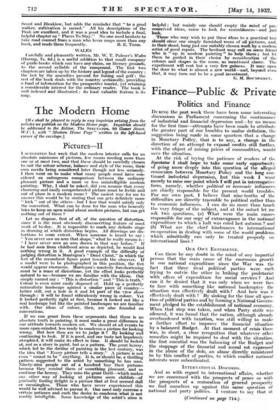Travel
[We publish on this page articles and notes which may help our readers in making their plans for travel. They are written by cor- respondents who have visited the places described. We shall be glad to answer questions arising out of the Travel articles pub- lished in our columns. Enquiries should be-addressed to the Travel Manager, The SrEcrAron, 99 Gower Street, w.c.1.1 Roads and Byways Ir may be brutality to suggest that long distance walkers should, by adding to their loads, come to look more like higglers than they do already, but there is no doubt that Miss Anderson's book will add to the joys of the road. And since Heaven is only Heaven by contrast, blistered walkers will know themselves in paradise at least. when they have read her chapter on "The Foundras Highroads," and been reminded -of Defoe's description of a journey to church : "Not far from Lewes, I saw an ancient lady, and a lady of very good quality I assure you, drawn to church in her coach with six oxen ; nor was it done in frolic or humour, but meer necessity, tin way being so stiff and deep that no horses could go into it."
The weariest traveller may make a song out of the words of another sixteenth-century writer, Daniel Bourne" These horrible, stone deep, miry, uncomfortable, dreary roads ! "
It is amusing, too, in these days of bandits to read that in 1258, the Statute of Winchester ordained that "highways, leading from one market town to another shall be enlarged where as bushes, woods, or dykes be, so that there be neither dyke nor bush whereby a man may lurk to do hurt within 200 feet of the one side and 200 feet of the other side of the way."
The author begins with a description of the track-way system, and devotes a chapter to her exploitation of the theory that these track-ways had a religious as well as an economic significance. There follows an account of the Roman Roads and of transport in the dark ages, following the withdrawal of the Roman Legions. After the Anglo- Saxons had cleared the valleys with their eight-ox ploughs they still continued to use the early highways—Ermine Street, and Watling Street, the Fosse Way and the Ieknield Way. There is no space here in which to quote from the many interesting details of mediaeval roads and their travellers. In those days, riverways were more crowded than highways, but as commerce increased and merchants grew more adven- turous, itineraries and maps were made, Lords of the Manor bestirred themselves, and poor villagers were taxed unduly in order that travellers from town to town might •journey more comfortably. The author is at her most interesting when describing all this, explaining the abuses of the turnpike system and the beginning of reform in the seventeenth century, up to which time one of the roads to Tilbury was so narrow that "a mouse could not pass by any carriage ! "
The book concludes, after a tribute to Macadam, some chapters on railways and nineteenth-century road adminis- tration, with a valuable bibliography. Travellers who buy the book will be grateful to Miss Anderson for her review of our roads, for the numerous sketch-maps and for her spiritual restoration of old highways. There is sc-arcely a district in Southern England that she has not enlivened for us, from Wey- mouth where George III bathed to the tune of God Save the King to St. Albans whose river parted like the Red Sea on the day when the Saint was executed. She reminds us, too, of the not untimely words of Mrs. Celia Fiennes who, in her book, Through England on a Side-saddle in the Time of William and Mary, deplored "the evil Itch of over-valueing fforeign parts."
Mr. Patrick Monkhouse and Mr. Donald Boyd have written books which will be particularly useful to travellers in the north country. Mr Boyd- begins with an introduction to Yorkshire, "its human beings, complexion maps and hill- shapes," and shows that he was early infected with the fever of foot-travel by his father who refused to buy return tickets at a toll-bridge because he said he might never return. His book, which includes directions for walks in the Leeds 'district, in Wharfedale and Ribblesdale, along the Cleveland coast, up Penyghent and Ingleborough and in the border country is graphically and amusingly written, and at the end comes a very welcome collection of Yorkshire recipes.
Mr. Monkhouse has a good deal to say about Roman roads, and says it extremely well. He iSSi more formal and didactic guide than Mr. Boyd, who gives accounts of personal walks and enlivens them with anecdote ; and has, therefore, more space in which to direct his readers. . some rather guarded paragraphs on trespass, he tells how it is possible, given convenient conscience, to reach the top of Kinder
Scout and Bleaklow, but adds the reminder that "to a good walker, cultivation is sacred." All his descriptions of the Peak are excellent, and it was a good idea to include a final, helpful chapter on " Places To Stay." No one need hesitate to take road counsel from a man who loves maps more than any book, and reads them frequently. B. E. Tono.





































 Previous page
Previous page